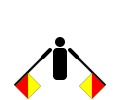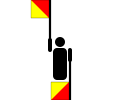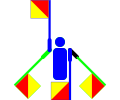Gerald Holtom
| Anti-nuclear movement |
|---|
 |
| By country |
|
| Lists |
Gerald Herbert Holtom (20 January 1914 – 18 September 1985
ND symbol
Educated at Gresham's School in Holt, Norfolk, Holtom was a graduate of the Royal College of Art in London. He had been a conscientious objector during World War II.[1] In 1958, he was working for the Ministry of Education.[7]
On 21 February 1958 he designed the nuclear disarmament logo for the first Aldermaston March, organised by the Direct Action Committee against Nuclear War (DAC) in Easter 1958 (4–7 April).
There are differing accounts of how the design was conceived. According to CND, Holtom had been invited by the DAC to design artwork for the Aldermaston March. He showed his preliminary sketches to a DAC meeting in February 1958 at the
Trademark registration of the logo was never carried out, and since the 1960s the logo has become known to, and used by, the public as a general-purpose
-
ND Symbol
-
N
-
D
-
ND
In addition to this primary genesis, Holtom additionally cited as inspiration Goya's Peasant Before the Firing Squad:[9]
I was in despair. Deep despair. I drew myself: the representative of an individual in despair, with hands palm outstretched outwards and downwards in the manner of Goya's peasant before the firing squad. I formalised the drawing into a line and put a circle round it.[13]
The reference is to Goya's The Third of May 1808 (1814), although the peasant shown in this painting has his arms stretched upwards, not downwards.
Personal life
Holtom had six children, including four with his first wife: Peter, Julia, Anna (now Anna Scott, an artist) [14] and Benjamin; and two with his second wife: Darius and Rebecca (also an artist).[15]
See also
References
- ^ a b Westcott, Kathryn (20 March 2008) "World's best-known protest symbol turns 50" BBC.co.uk (News) (Retrieved: 21 February 2010)
- ^ Roth, Richard (23 March 2008). "The 50th Anniversary Of The Peace Symbol". CBS Interactive Inc. Retrieved 20 April 2008.
- ^ Roth, Richard (20 April 2008). "CBS Sunday Morning, 3/23/08, Origin of the Peace Sign (timecode 5:13)". CBS Interactive Inc. Archived from the original on 28 May 2008. Retrieved 20 April 2008.
- ^ "Holtom gravestone". Archived from the original (bitmap image) on 28 May 2008. Retrieved 20 April 2008.
- ^ Ken Kolsbun with Mike Sweeney Peace: The Biography of a symbol (Retrieved: 26 December 2010)
- ^ Darius Holtom Gerald Holtom - Designer of the Peace Symbol, Spokesman Books, Nottingham
- ^ a b c Christopher Driver, The Disarmers: A Study in Protest, London: Hodder and Stoughton, 1964
- ^ "The CND logo -". 13 February 2018. Archived from the original on 13 March 2016. Retrieved 21 February 2021.
- ^ ISSN 1040-2659.
- S2CID 146264104.
- CNDUK.org (Retrieved: 21 February 2010)
- ^ McCarthy, Michael (15 October 2005) "Whatever happened to CND?" Archived 30 September 2007 at the Wayback Machine Independent.co.uk (Retrieved: 21 February 2010)
- ^ "History of the Symbol". Campaign for Nuclear Disarmament. Retrieved 8 May 2019.
- ^ "Father & Daughter still competing after 50 years.......50 Years after her father Gerald Holtom, created the now iconic CND symbol, Anna Scott (nee Holtom) is exhibiting her own works at a Mayfair Gallery". 17 March 2008. Retrieved 18 June 2012.
- ^ Sloan, Liam (25 March 2008). "Fifty years of peace symbol". NewburyToday.co.uk. Archived from the original on 19 July 2011. Retrieved 22 February 2010.
Further reading
Darius Holtom, Gerlad Holtom - Designer of the Peace Symbol, Spokesman Books, Nottingham[1]
External links
- ^ Darius Holtom Gerald Holtom - Designer of the Peace Symbol, Spokesman Books, Nottingham




